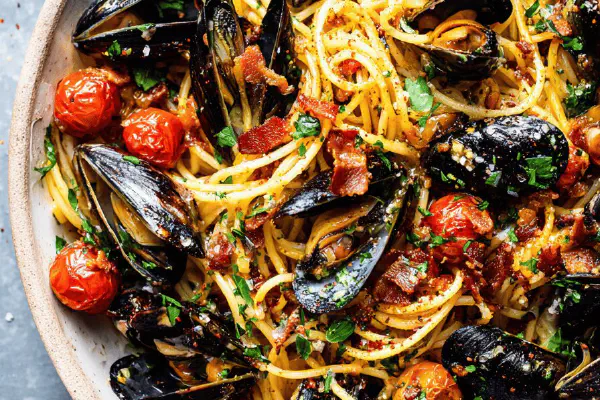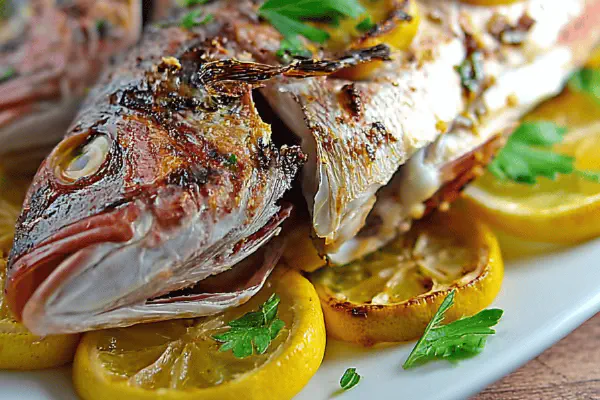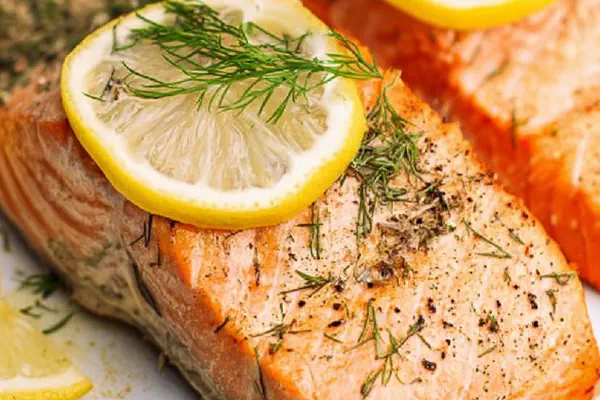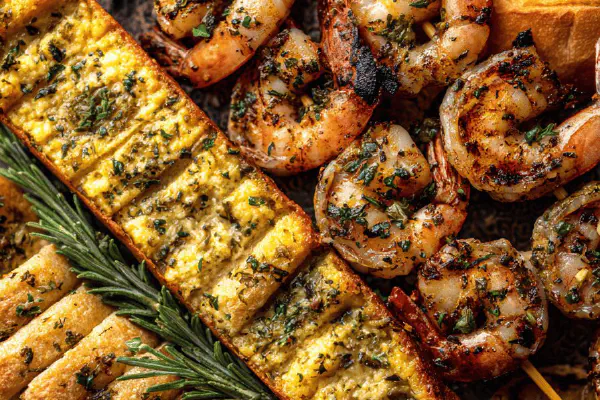Grilled Whole Fish Lemon Herbs
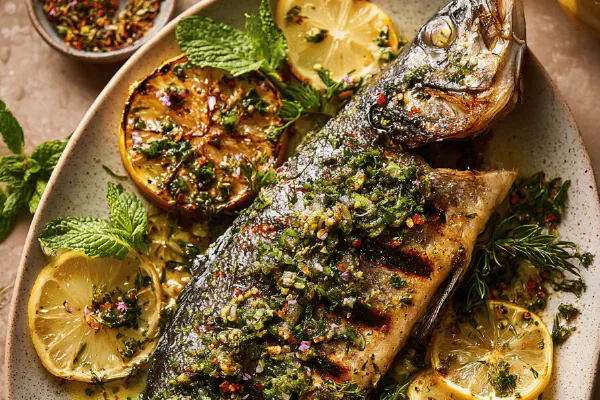
By Emma
Certified Culinary Professional
Ingredients
- 4 whole sea bass or similar fish approx 450 g (1 lb) each, scaled and gutted
- 4 lemons thinly sliced
- 4 sprigs thyme fresh
- 4 sprigs parsley fresh
- 4 sprigs dill fresh
- 4 sprigs basil fresh (replaced fennel)
- 4 cloves garlic minced
- 1 medium red onion sliced thin
- Extra virgin olive oil
- Coarse sea salt
- Fresh cracked black pepper
About the ingredients
Method
- Prep charcoal or gas grill to medium heat and oil grates well. If you get impatient and the fish sticks, use a fish basket or foil as backup. Nothing worse than skin ripping off.
- Score fish skin with 3 deep diagonal slashes per side, not too shallow or afraid, this helps heat penetrate and skin crisp without bursting flesh out.
- Stuff cavity with lemon slices, garlic, herbs, and onion. The aromatics infuse from inside out, skip stuffing and you lose layers of flavor.
- Brush fish exterior generously with oil. Salt and pepper both inside and out. Salt early here draws moisture but also primes skin crisp.
- Place fish on hot grill surface, listen for that instant sizzle and smell fresh lemon mingling with smoke. Grill with lid closed to trap heat.
- Turn after 7-9 minutes, depending on thickness. Skin should brown and crisp, flesh firm but still yielding. Watch juices run clear.
- Flip carefully, brush with more oil to prevent drying. Cook second side another 7-9 minutes. Total cook closer to 20-22 minutes but rely on texture more than time.
- Skins turn golden bronze, fins lightly crisp, flesh flaking near bones when poked with fork but still moist inside. If tail curls, a good sign it's done.
- Remove fish from grill, rest 5 minutes before serving. Resting helps juices redistribute, don’t skip or fish dries out fast.
- Serve with extra lemon wedges to squeeze. A drizzle of good olive oil, maybe sprinkle fresh chopped herbs if you have on hand.
Cooking tips
Chef's notes
- 💡 Score skin with firm strokes—not light. Three diagonal slashes each side. Too shallow and heat won’t penetrate. Too deep and juices spill, flesh bursts out. Skin crispness depends on this technique; it controls steam escape and texture. Practice on smaller fish if unsure. Always prep oil grates well to avoid skin sticking and tearing during flips. Use fish basket if impatient or grates porous. Heat has to be medium, not scorching. Charred skin means burnt edges but raw flesh inside.
- 💡 Stuff cavity tight with lemon slices, fresh garlic, herbs, and onion. Aromas push out under skin scoring. Skip stuffing and flavor flattens. Herbs selection is personal but basil beats fennel for less anise and sweeter green notes. Use sprigs whole rather than chopped to avoid bits falling out. Onion adds mild sweetness but omit if strong onion taste unwanted. Oil generously inside cavity too to keep flesh moist. Salt inside and out early pulls moisture but also firms flesh. Timing is secondary to texture and smell.
- 💡 Brush fish outside with extra virgin olive oil thick coat—skip or skimpy oil means skin sticks and tears or soggy peel. Salt coarse sea salt only for crunch and enhanced crust. Fresh cracked black pepper adds texture but don’t overdo. Use tongs or wide slack spatula to flip gently; skin fragile after initial crunch sets. Watch juices run clear near slashes; cloudy juices mean undercooked. Turn skin from last to first side, so second side cooks evenly. Total time varies by thickness and fish type. Use tail curl as done signal. Never rely only on timer.
- 💡 Grill lid closed traps heat and smoke, elevates temp for even cook inside but monitor closely or risk dry edges with raw center. Char aromas come from citrus oils vaporizing, listen for sizzle and smell fresh lemon mingling with smoke, that’s when to flip. Rest fish off heat minimum 5 minutes; juices redistribute and make flesh tender again. Skip resting and juices seep out on plate or fork. If no grill, use cast iron grill pan on high heat, less smoky and shorter time. Always test doneness by flaking flesh near backbone, never just timer.
- 💡 If fish sticks despite oil, try foil layer or fish basket. Skin ripping ruins texture and presentation. Scoring helps but not foolproof; the fish type decides crisp success. Sea bass is good substitute for branzino or snapper. Swap herbs as you please but basil made skin shine brighter without overpowering garlic. Zest lemon into flesh for sharper zing if lemon slices aren’t enough. Garlic quantity can be reduced if overwhelmed. Cooking times approximate; rely on skin texture, sizzle, juice clarity, and tail curl to judge done state.
Common questions
How to tell when fish is cooked without timer?
Skin color key—golden bronze with crisp edges. Juices run clear near slashes. Flesh flakes near backbone but still moist. Tail curling upwards is another sign. Listen for steady sizzle; smoke smell bright with lemon helps timing. Don’t trust time alone, thickness varies and impacts cook time.
Can I substitute other fish than sea bass?
Yes, firm white fish best—branzino, snapper. Must be whole, scaled, gutted. Skin thickness matters for scoring effect. Flesh texture impacts cooking times slightly. Adjust times and watch texture cues. Avoid oily fish or those with thick skin unless you adapt scoring and oiling approach.
What’s the best way to prevent fish from sticking to grill?
Oil grates generously and before preheating grill. Use extra virgin olive oil for moisture and crisp skin. Score skin deeply. If sticking persists, fish basket or foil layer under fish saves skin from tearing. Flip gently using wide spatula. Don’t move fish until initial crust forms—typically first 7–9 minutes. Avoid scorching heat.
How should leftovers be stored and reheated?
Cool fish quickly, store wrapped in fridge 1–2 days max. Reheat gently—cast iron pan with light oil or oven at low temp prevent drying out. Avoid microwave which can toughen flesh. Leftover fish can be cold flaked into salads or sandwiches too. For longer storage freeze wrapped well, lose some texture but keep flavor. Thaw overnight in fridge before reheating carefully.
